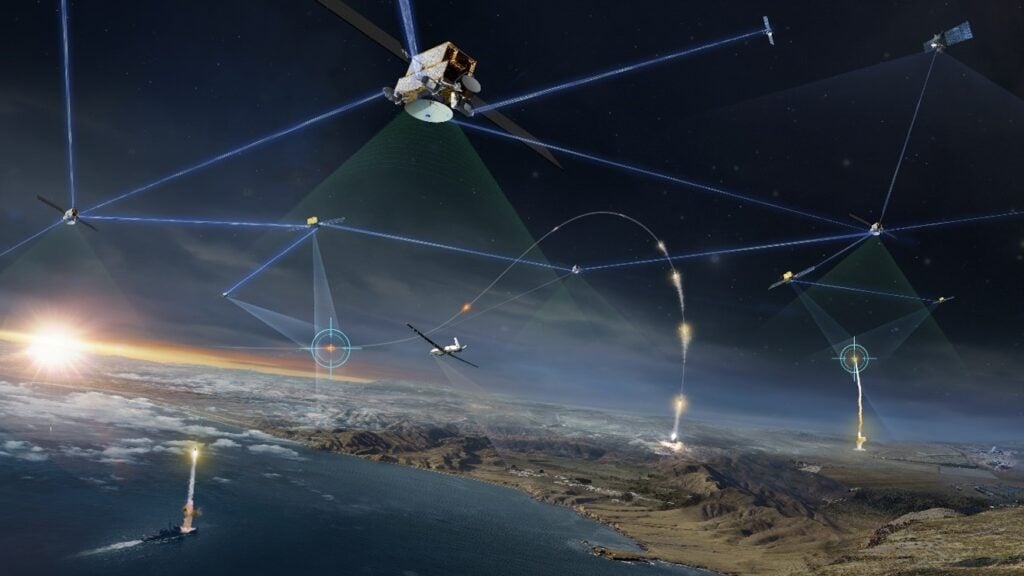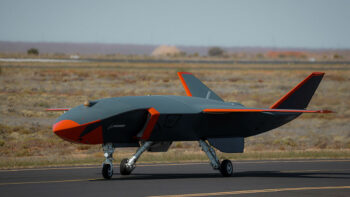
The Space Development Agency will begin launching its first operational data transport satellites in 2024, part of the Space Force’s effort to build a space version of the internet. (Image: Northrop Grumman)
WASHINGTON — The Space Force’s Space Development Agency has tapped SAIC to build and maintain a cloud-based “application factory” to design, develop, test and deploy “cyber-resilient” battle management, command, control communications (BMC3) software for its planned satellites in low Earth orbit, according to SDA and company officials.
“We’re responsible for integrating command and control software, cyber and cloud into kind of an integrated engineering solution,” explained David Ray, senior vice president for SAIC’s space business in a mid-June interview. “So, it’s going to be the central infrastructure where folks who deploy satellites, people who build mission-unique software applications, they’ll come there, they’ll get wrung out from a testing perspective, really understand kind of the interoperability in the in the confines of a modular framework for all applications, and then get deployed to both ground stations and satellites.”
Ray compared SAIC’s task to the process Apple uses to verify and test applications made by outside vendors for its iPhone before allowing them to be carried and downloaded by users. The process enabled by the software environment is game-changing, because in the end it will allow “satellites to be upgraded in space,” he added.
BMC3 software “compute modules” will be critical in ensuring that the satellites in SDA’s multi-mission Proliferated Warfighter Space Architecture (PWSA) can shuttle information amongst themselves and, most importantly, down to operators on the ground, an SDA spokesperson explained in a June 9 email. The Applications Factory software environment, in essence, will be used to develop those modules and make sure they are ready for prime time.
“BMC3 modules combined with the BMC3 AppFac [Application Factory] is the ecosystem that provides on-orbit processing capabilities to accelerate delivery of information to the warfighter,” the SDA spokesperson said. “SAIC will guide the BMC3 mission application software developers through testing and deployment. In the process they will implement the developer security operations (integration of security testing at every stage of the development process), software lifecycle, enabling secure development, testing, and rapid deployment of BMC3 mission applications to the PWSA.”
Under the SDA contract, worth up to $64 million over four years, SAIC will “develop and implement and maintain the architecture and the infrastructure, which is mainly software and some hardware components” to create a “clearing house, if you will, for other contractors as they build mission-unique applications,” Ray explained.
“The span of the work is two to four years,” he added.
The apps developed in the factory “will range in function from providing on-orbit security monitoring of data traversing the PWSA network to providing mission specific processing and dissemination capabilities for tactical users and warfighting systems,” the SDA spokesperson said.
SDA’s June 8 contract announcement said that SAIC also will be responsible for development of the factory’s first BMC3 app, the “secure interoperable-middleware layer (SIL)” that “provides future mission applications the ability to leverage the Tranche 1 Transport Layer vendors’ BMC3 payloads.”
Middleware allows a software application to interface with “different underlying operating systems or hardware,” the SDA spokesperson explained.
Ray noted that the idea is to allow all kinds of difference applications from different vendors to use common systems, be tested in the same way and be used across different satellites and ground systems.
“So if I’m building one thing in one part of the country for a command and control satellite, and I may be building something else for, let’s say, process dissemination, those may have been built in different environments, but I’m building an infrastructure to allow those to be interoperable and allow to have common process by which I’m testing and verifying before I’m actually deploying it to a satellite or ground station,” he said.
SDA’s Transport Layer will comprise 300 to 500 communications satellites designed to transmit a high volume of data with very little delay to military users on the ground, at sea, in the air, as well as too and from other satellites. As such, it has been designated as a key node in the Defense Department’s Joint All Domain Command and Control (JADC2) concept to rapidly and seamlessly link sensors and shooters across all the military services.
The Transport Layer’s Tranche 1, comprising 126 satellites, are expected to provide a first real operational capability. SDA last February awarded York Space Systems, Lockheed Martin Space, and Northrop Grumman Space Systems Tranche 1 development contracts worth a total of $1.8 billion, with a planned launch date of September 2024.






















